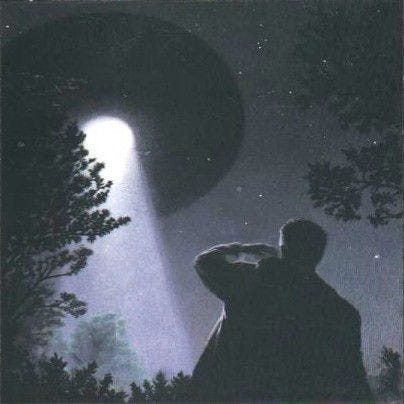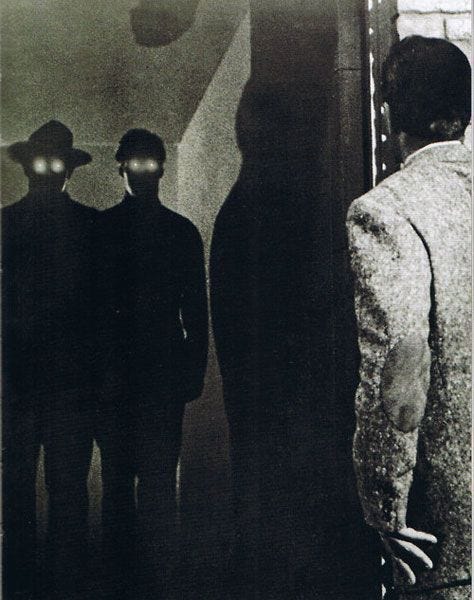The enigmatic Men in Black (MiB) have captivated public imagination for decades, representing one of the most intriguing aspects of UFO folklore. These mysterious figures first entered widespread public consciousness in the 1950s and have since become deeply embedded in both paranormal culture and popular entertainment.
The archetypal Men in Black are described as unusually tall, thin men wearing pristine black suits, ties, and sunglasses, often appearing in groups of two or three. Witnesses consistently report that these figures possess an unsettling appearance, with extremely pale, waxy skin and rigid, almost mechanical movements. Their behaviour is frequently described as simultaneously threatening and absurd, combining intimidating warnings with peculiar social awkwardness that suggests an incomplete understanding of human interaction.
The first widely documented MiB encounter occurred in 1947 when Harold Dahl reported a UFO sighting over Puget Sound, Washington. The following day, Dahl claimed he was visited by a man in a black suit who warned him not to discuss his experience. This encounter established several patterns that would become hallmarks of future MiB reports: the threatening undertones, the immediate timing following a UFO sighting, and the emphasis on maintaining silence about the witnessed events. However, it was Albert K. Bender who truly crystallised the modern conception of the Men in Black. In 1953, Bender, who ran the International Flying Saucer Bureau, abruptly shut down his organisation after claiming to have been visited by three men in dark suits who possessed supernatural abilities. Bender's account, published in his 1962 book "Flying Saucers and the Three Men," described these visitors as wearing identical black suits and causing him to feel physically ill in their presence.
The psychological impact of MiB encounters on witnesses has been profound and lasting. Many report experiencing severe anxiety and paranoia following their visitations, with some developing long-term sleep disorders or becoming reluctant to discuss their experiences even years later. The confrontational nature of these encounters, combined with the visitors' otherworldly characteristics, appears to create a unique form of trauma that bridges the gap between supernatural terror and real-world intimidation. Some researchers have noted interesting patterns in how MiB encounters affect different types of witnesses. Those who have had previous paranormal experiences often report feeling a sense of recognition or inevitability about their MiB encounters, as though these visitations were a natural escalation of their involvement with unexplained phenomena. In contrast, individuals with no prior interest in UFOs or the paranormal frequently describe their encounters as more psychologically devastating, perhaps due to the sudden disruption of their established worldview.
The social impact of the Men in Black phenomenon extends beyond individual witnesses. These encounters have influenced how people engage with and report unusual experiences, creating a kind of self-censorship within the UFO research community. Some witnesses have admitted to withholding details of their sightings out of fear of receiving an MiB visit, whilst others have become more determined to share their stories despite perceived risks.
The cultural significance of Men in Black has evolved significantly since the 1950s. What began as a frightening aspect of UFO encounters has transformed into a rich vein of popular culture, most notably through the successful film franchise starring Will Smith and Tommy Lee Jones. This popularisation has had a complex effect on genuine MiB encounters, with some witnesses becoming reluctant to report their experiences for fear of being associated with Hollywood fiction rather than genuine phenomena.
Interestingly, the appearance and behaviour of reported Men in Black has shown subtle changes over time, perhaps reflecting shifting cultural anxieties. Early accounts often emphasised their communist-like appearance during the Cold War era, whilst more recent reports frequently describe them as having an artificial or technological aspect, possibly reflecting modern concerns about surveillance and artificial intelligence. The academic study of MiB encounters has revealed fascinating patterns in how these experiences affect different cultures. In Britain, for instance, reports often describe more reserved and bureaucratic behaviour from the mysterious visitors, whilst American accounts typically emphasise more aggressive and threatening interactions. This cultural variation suggests that the phenomenon may adapt to local social norms whilst maintaining its core characteristics.
The psychological aftermath of MiB encounters often extends to witnesses' immediate social circles. Family members and close friends frequently report experiencing secondary trauma, particularly when the primary witness exhibits significant behavioural changes following their encounter. This ripple effect has been documented in numerous cases, where entire households have been affected by a single family member's MiB experience. Modern technology has introduced new dimensions to the MiB phenomenon. Witnesses now regularly report electronic interference accompanying MiB encounters, including mobile phone malfunctions, computer issues, and CCTV systems failing during crucial moments. These technological aspects have added a contemporary layer to the traditional narrative, suggesting that the phenomenon continues to evolve alongside human society.
The lasting impact of Men in Black encounters on witnesses often manifests in unexpected ways. Many report developing a heightened awareness of surveillance and a persistent feeling of being watched. Others describe experiencing significant life changes following their encounters, including career shifts, relocations, or dramatic alterations in their belief systems. These long-term effects suggest that MiB experiences represent more than simple intimidation attempts; they appear to function as profound psychological events that can reshape a person's entire worldview. Contemporary researchers have noted an interesting trend in how younger generations interpret and report MiB encounters. Those raised in the digital age often describe these experiences through the lens of modern conspiracy theories, incorporating elements of government surveillance programmes and corporate control into their narratives. This evolution in interpretation demonstrates how the phenomenon continues to reflect society's current fears and preoccupations.
The Men in Black phenomenon remains one of the most compelling aspects of UFO mythology, notable for its consistency across time and cultures despite significant social changes. Its impact on witnesses and society continues to generate discussion and debate, whilst its influence on popular culture shows no signs of diminishing. Whether viewed as genuine supernatural encounters, government agents, or manifestations of psychological phenomena, the Men in Black continue to represent a unique intersection of paranormal experience and social control, affecting witnesses and researchers in ways that merit ongoing study and consideration.
👁️🗨️ What do you believe?
Have you or someone you know ever encountered something that defies explanation? 👀 Whether you're a skeptic, a believer, or somewhere in between, we want to hear your thoughts.
🖤 Drop your theories, personal stories, or questions in the comments.









